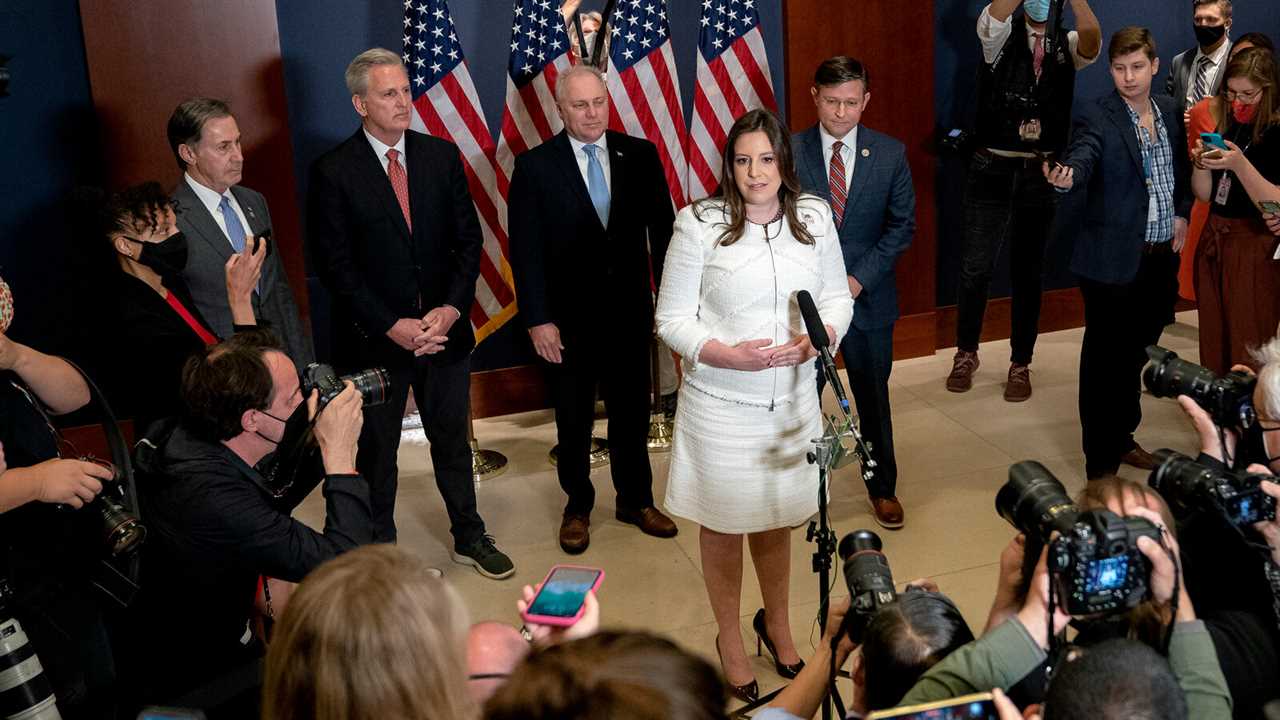
WASHINGTON — As Representative Elise Stefanik of New York watched then-candidate Donald J. Trump take her party by storm and win the Republican presidential nomination in 2016, she was so skeptical of his inflammatory style and hard-right positions that she refused — even when pressed — to say his name.
But on Friday, minutes after she was elected to her party’s No. 3 House post as part of a Republican leadership purge that targeted a leading critic of Mr. Trump, the former president’s was one of the first names she uttered.
Having won Mr. Trump’s endorsement for the leadership position as she parroted some of his false claims about fraud in the 2020 election, Ms. Stefanik sang his praises, capping a remarkable metamorphosis by the 36-year-old congresswoman that mirrors the G.O.P.’s evolution into a party made entirely in his image.
“Voters determine the leader of the Republican Party, and President Trump is the leader that they look to,” Ms. Stefanik said, after thanking the former president. “I support President Trump, voters support President Trump; he is an important voice in our Republican Party and we look forward to working with him.”
The 134-46 vote to elevate Ms. Stefanik was the capstone on a campaign by Republicans to force out Representative Liz Cheney of Wyoming, who had angered her colleagues by repudiating Mr. Trump’s election lies and insisting he should have no place in the party going forward.
Ms. Stefanik’s swift rise to replace her cemented a litmus test for the party’s leaders of unswerving loyalty to Mr. Trump. It was also a striking culmination of her own political journey, from disciple of the once-dominant establishment wing of the Republican Party to an outspoken Trump acolyte.
That conversion mirrors not only that of Ms. Stefanik’s district in New York’s North Country, but of the Republican Party itself, as one-time critics of the former president have either stepped aside, held their tongues for fear of drawing a backlash from Mr. Trump’s loyal base, or, in Ms. Stefanik’s case, reinvented themselves altogether to capitalize on the zeal of his supporters.
“The base of our party has listened to President Trump,” said Representative Ken Buck, Republican of Colorado. “And there’s a lot of feedback.”
When Ms. Stefanik first came to Congress in 2014 — then the youngest woman ever elected — she was viewed as a rising star in the mold of then-Speaker Paul Ryan of Wisconsin, who had hired her to work on his 2012 campaign for vice president and whom she later credited in part with inspiring her to run for Congress. A graduate of Harvard and an alumna of former President George W. Bush’s administration, she presented herself as a moderate pragmatist willing to work with Democrats and hoping to expand the party’s appeal, especially to women and younger voters.
“I will work with anyone, regardless of their party affiliation, to get it done,” Ms. Stefanik had said. “Republicans, Democrats, independents, even Green Party — if you have a good idea, I’m willing to work with you to get the job done.”
In an interview with a local radio station in 2015, she trumpeted her work with a group of moderate Republicans, who she said were “more of the governing caucus within the Republican Party,” and landed a thinly veiled jab at the ultraconservative members of the House Freedom Caucus without naming them, suggesting that they had not used “the most appropriate tenor” and had provoked “internal squabbling.”
“Elise Stefanik is a builder — no easy feat in an age when so much of politics is about tearing people down,” Mr. Ryan wrote in 2019 when she was named a rising star by Time magazine. “Elise has built a record as an authentic, respected voice for ideas and common sense.”
Even after Mr. Trump was elected, Ms. Stefanik kept her distance, voting against his emergency declaration to build a wall on the southern border and against his signature 2017 tax cuts bill. A member of the Intelligence Committee, she boasted about supporting special counsel Robert S. Mueller III’s investigation into links between the Trump campaign and Russia and being “one of the first members” to call for transparency in regards to the report.
But Ms. Stefanik was already starting to move closer to Mr. Trump, having taken note of his 2016 romp in her district, a 14-point victory in a swath of upstate New York that had favored former President Barack Obama twice by large margins.
“I really paid attention to the voters and the people in my district,” she told Steve Bannon, a former Trump adviser, in an interview last week. “And it was really stunning to see the amount of Trump signs popping up, the number of people attending Republican rallies, people that had never come to political rallies before turning out to vote.”
Just before the 2018 midterm elections, she invited Mr. Trump to her district to sign the annual defense bill at Fort Drum and shared the stage with him, though she pointedly declined to praise him during her brief remarks.
Even as she was allying herself with Mr. Trump, Ms. Stefanik was playing a leading role in countering his effect on the Republican Party, which lost its House majority that year in part because suburban women were alienated by him. She began an intensive drive to recruit and elect more G.O.P. women, raising huge sums for the task.
But by the following year, with Mr. Trump facing his first impeachment, Ms. Stefanik made it clear she was no longer reluctant to be associated with him. The starkest indication of her shift came during his hearings and subsequent Senate trial, when the New York Republican served as one of the former president’s defenders.






